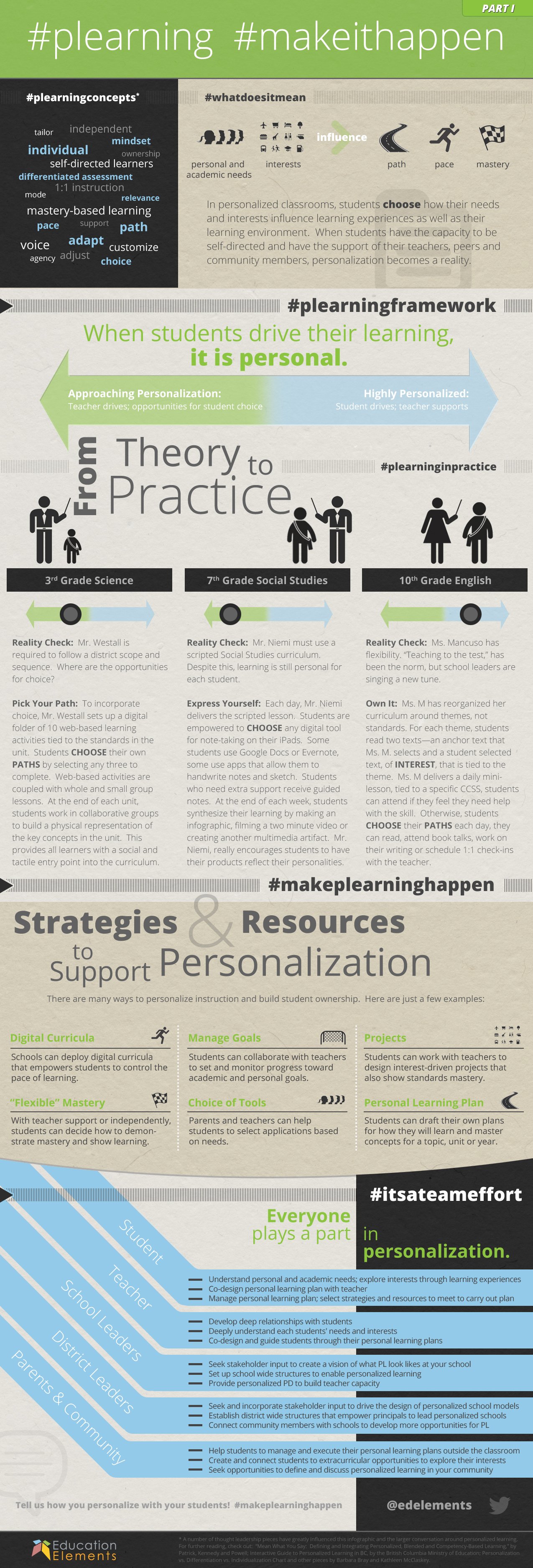Feeling confused about personalized learning? Not sure what it means, what it looks like, how to implement or support it? You’ve come to the right place. We hope to answer your questions through our #plearning infographic series. In part one #plearning#makeithappen (below) we’ll arm you with a definition for personalized learning, examples of what it might look like in the classroom and concrete strategies and resources to support the personalized classroom. In part two #plearningframework (coming soon!), we will offer a tangible framework to make personalized learning happen in your classroom. Parts three #makeplearninghappen and four #plearning#itsateameffort will offer insight into implementation and stakeholder support, respectively.
Before jumping to the infographic, think about the current buzz around personalized learning. Though some may believe it is a new approach to learning, it is not. It has roots in Progressive Education which gained notoriety in the early 1900s. This approach prizes student-centered, constructivist methods of teaching and learning. It empowers students to learn based on need and interest--not based on requirements. Historically, personalized learning was limited to classrooms in progressive schools. While it has not yet become part “mainstream” public school education, many teachers have been making an effort to personalize learning.
Take, for example, Mr. Graham, my 7th grade English teacher (from a few decades ago!). Whereas my other public school teachers kindly treated us like widgets on an assembly line (i.e., we learned the same material on the same day, in the same way, at the same pace), Mr. Graham had a strikingly different approach. If you had to put a label on it, you could call his class 25% traditional English class, 75% writer’s workshop. Sure, sometimes he stood at the front of the room and taught us all the same lesson in the same way. However, the majority of the time we were just expected to write and show him that we mastered concepts through our writing. While he chose the genre, we chose everything else--topic, length, format, pictures, no pictures, etc. He would check in with us individually and help us bring our pieces to the next level. Sometimes that meant providing a quick lesson, other times constructive feedback on our writing and other times he served as a thought partner. All this to say, his was the only class where I felt in control of my learning and where I felt my interests really mattered.
What I realize now is that my other teachers did not teach us in the exact same way out of convenience or some sort of malintent. Rather, they approached teaching and learning in this way simply because that is how school was done, those were the expectations. Unfortunately, school continues to be “done” this way in countless classrooms across our country--lessons are geared toward students in the middle; interests are not accounted for; some students become bored, others frustrated, in short, learning is not student-centered. Hopefully, the resurgence of personalized learning and the actions educators will take as a result will transform school and the learning experience into something that is more meaningful and relevant for all students.
But what does personalized learning mean? What does it look like in action? Who does what? Check out first infographic for an introduction to personalized learning. Stay tuned for the next part of our series where we share a concrete framework to personalize learning at your school. We encourage you to contribute to the conversation by letting us know how you personalize learning in your school or classroom. Become part of the dialogue on twitter: @edelements #makeplearninghappen






